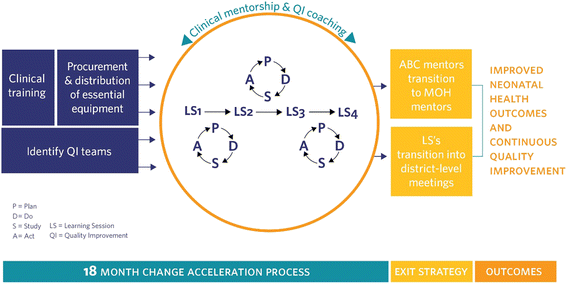Tackling the hard problems: implementation experience and lessons learned in newborn health from the African Health Initiative
- PMID: 29297352
- PMCID: PMC5763287
- DOI: 10.1186/s12913-017-2659-4
Tackling the hard problems: implementation experience and lessons learned in newborn health from the African Health Initiative
Abstract
Background: The Doris Duke Charitable Foundation's African Health Initiative supported the implementation of Population Health Implementation and Training (PHIT) Partnership health system strengthening interventions in designated areas of five countries: Ghana, Mozambique, Rwanda, Tanzania, and Zambia. All PHIT programs included health system strengthening interventions with child health outcomes from the outset, but all increasingly recognized the need to increase focus to improve health and outcomes in the first month of life. This paper uses a case study approach to describe interventions implemented in newborn health, compare approaches, and identify lessons learned across the programs' collective implementation experience.
Methods: Case studies were built using quantitative and qualitative methods, applying the World Health Organization Health Systems Strengthening Framework, and maternal, newborn and child health continuum of care framework. We identified the following five primary themes in health systems strengthening intervention strategies used to target improvement in newborn health, which were incorporated by all PHIT projects with varying results: health service delivery at the community level (Tanzania), combining community and health facility level interventions (Zambia), participatory information feedback and clinical training (Ghana), performance review and enhancement (Mozambique), and integrated clinical and system-level improvement (Rwanda), and used individual case studies to illustrate each of these themes.
Results: Tanzania and Zambia included significant community-based components, including mobilization and sensitization for increased uptake of essential services, while Ghana, Mozambique, and Rwanda focused more efforts on improving the quality of services delivered once a patient enters a health facility. All countries included aspects that improved communication across levels of the health system, whether through district-wide data sharing and peer learning networks in Mozambique and Rwanda, or improved referral processes and systems in Tanzania, Zambia, and Ghana.
Conclusion: Key lessons learned include the importance of focusing intervention components on addressing drivers of neonatal mortality across the maternal and newborn care continuum at all levels of the health system, matching efforts to improve service utilization with provision of high quality facility-based services, and the critical role of leadership to catalyze improvements in newborn health.
Keywords: Ghana; Health system strengthening; Maternal child health; Mozambique; Neonatal mortality; Newborn health; Quality of care; Rwanda; Tanzania; Zambia.
Conflict of interest statement
Authors’ information
Hema Magge, MD, MS; Roma Chilengi, MD, MSc; Elizabeth F. Jackson, PhD, MHS; Bradley H. Wagenaar, PhD, MPH; Almamy Malick Kante, PhD, MSc.
Ethics approval and consent to participate
Not applicable
Consent for publication
Not applicable
Competing interests
The authors declare that they have no competing interests.
Publisher’s Note
Springer Nature remains neutral with regard to jurisdictional claims in published maps and institutional affiliations.
Figures


References
-
- Liu L, et al. Global, regional, and national causes of child mortality in 2000–13, with projections to inform post-2015 priorities: an updated systematic analysis. Lancet. 2014;385:9966. - PubMed
Publication types
MeSH terms
LinkOut - more resources
Full Text Sources
Other Literature Sources
Medical

